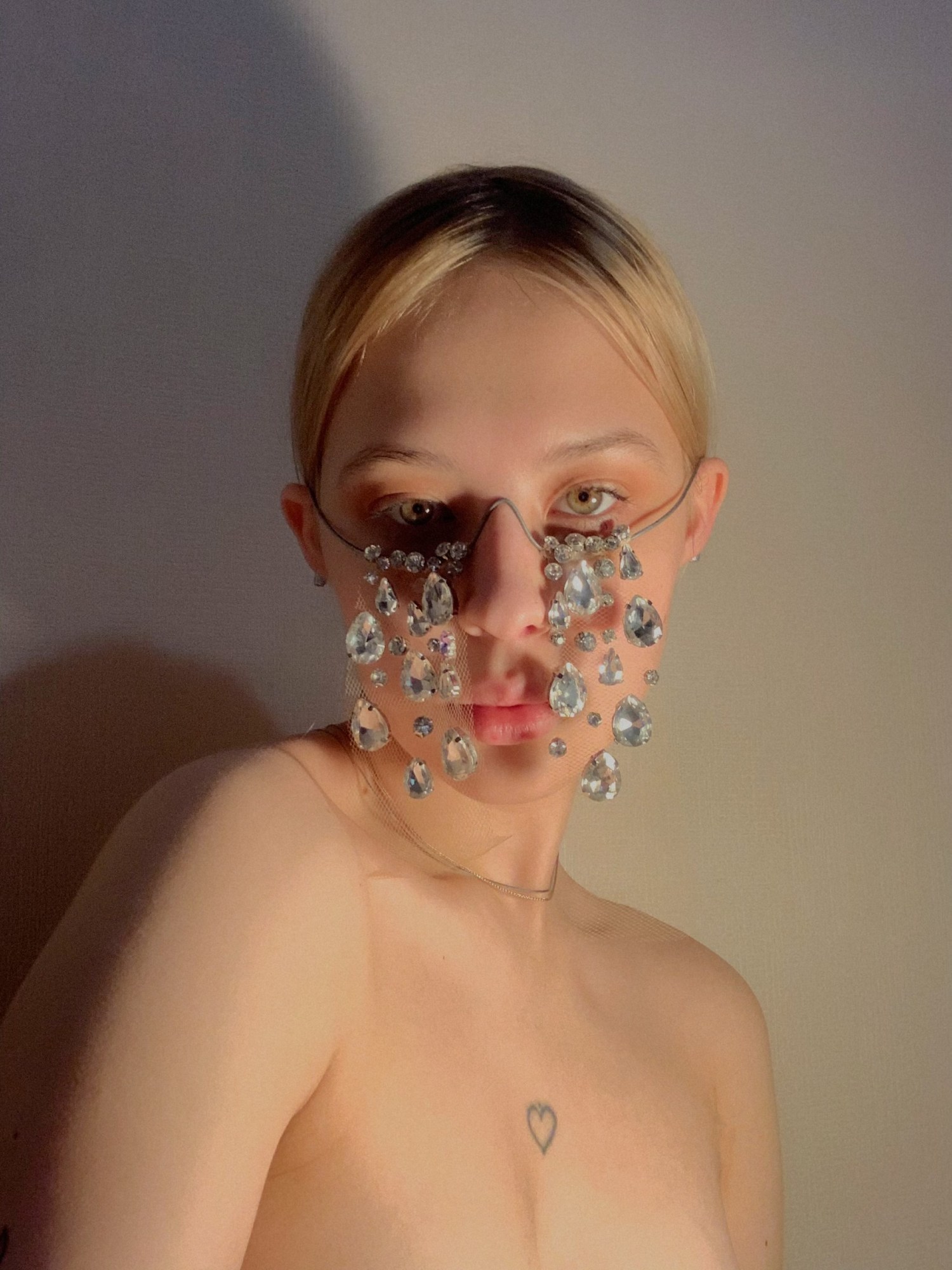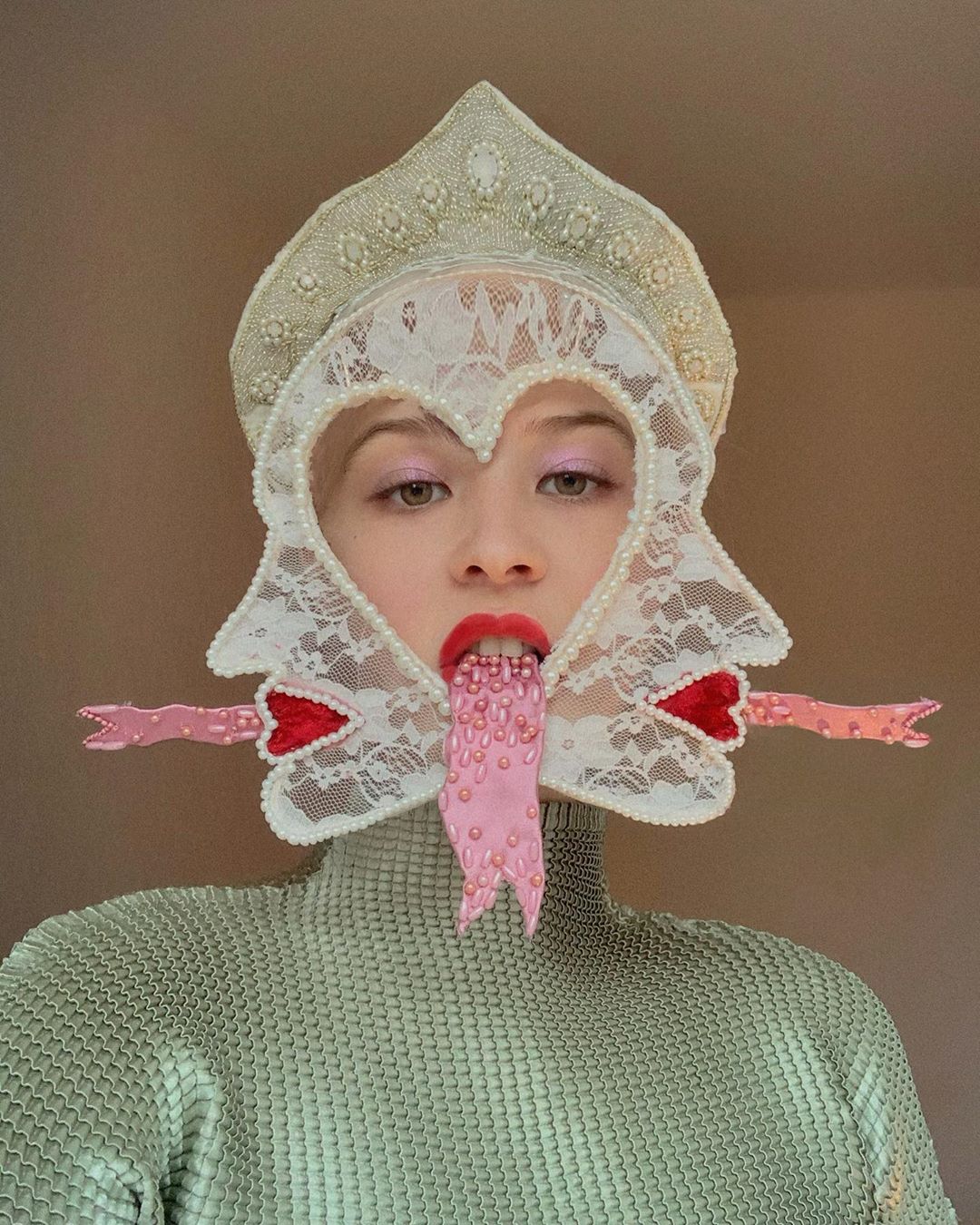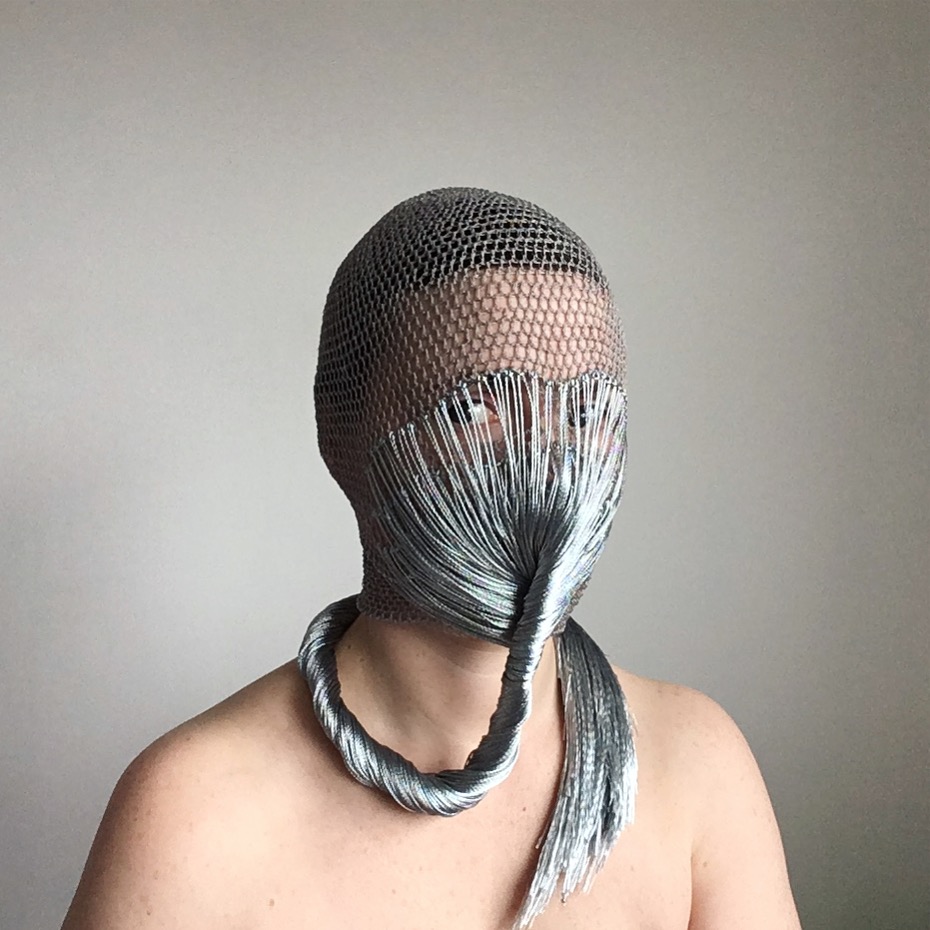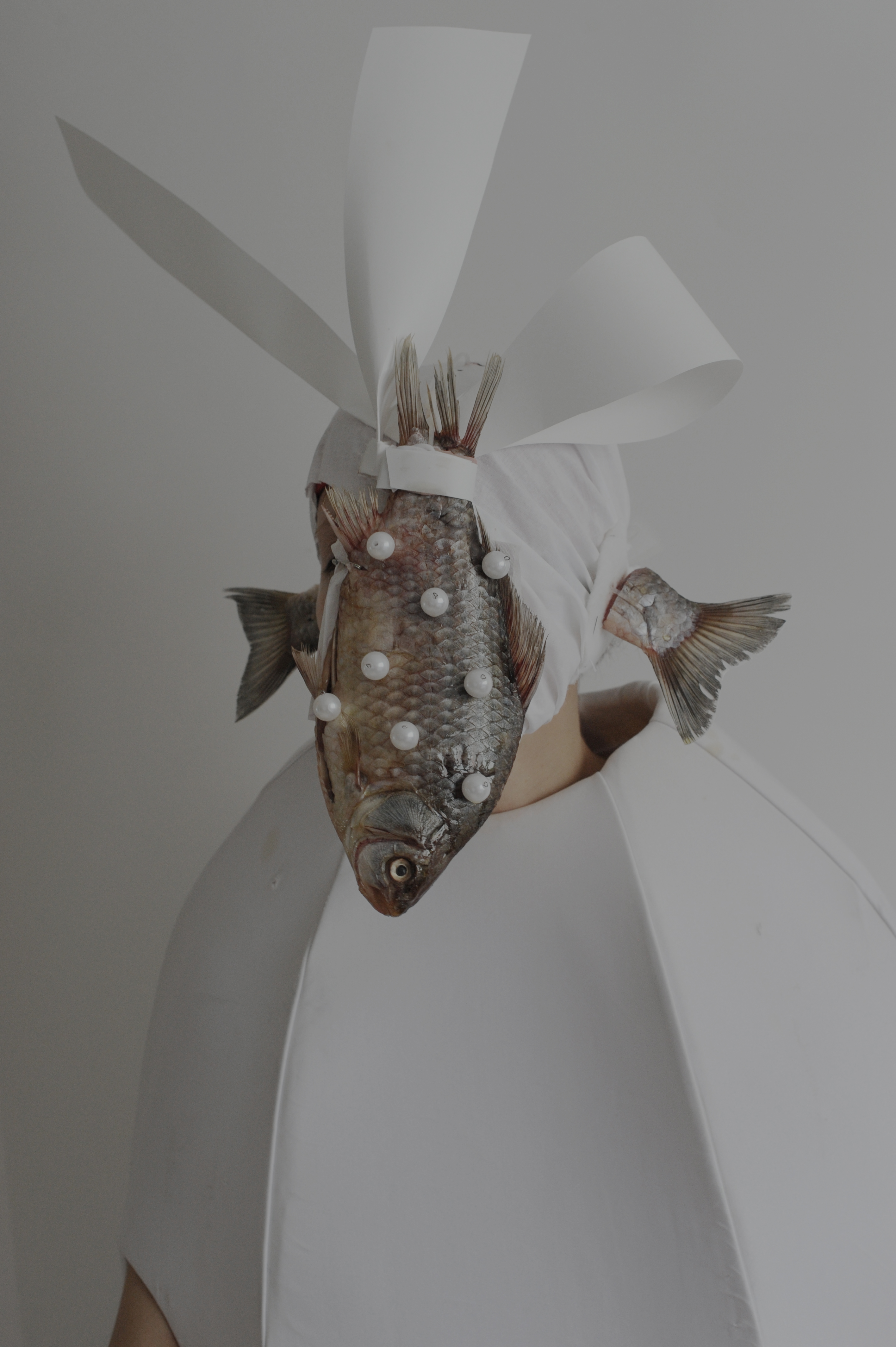The first association you might have with masks is that of ancient, folkloric traditions, which is understandable. Adorning our faces — whether to strike fear in combat, become mysterious at a ball, protect ourselves from plague, or to conjure rain — is one of the oldest traditions, practiced by virtually every culture on earth. While some may say these art forms have begun to disappear in our globalised world, a more positive take might be that mask-making has simply been adopted by a new generation who are using it to comment on modern phenomena.
With masks on our mind more than ever thanks to the coronavirus pandemic, i-D spoke to three designers who are keeping up with the venerable tradition of decorative mask-making but putting a contemporary spin on it.

Polina Osipova, St. Petersburg
Crystals dripping like tears from eyes, lace swans adorned with pearls, head pieces that have a Joan of Arc energy about them — these are all works by 21-year-old Russian designer Polina Osipova. Her delicate yet regal pieces recently caught the attention of Gucci, who commissioned her to create an intricate Instagram filter mask for them. Mixing folkloric art with an Insta-friendly aesthetic she serves a 21st century version of the glittery jewels worn by the tsarinas of the Russian court.
The designer was born and raised in Cheboksary, the capital city of Chuvash Republic, a small region in the heart of Central Russia. Often hailed as ‘The Land of a Hundred Thousand Songs and Embroideries’, it is known for its rivers, hop fields and rich folklore, something which has influenced Polina as an artist today. “All of my works are at least partially imbued with my Chuvash heritage,” she explains. Take embroidery, for example, a craft that has been running through her family for generations: “All the women can do it, and I was taught from a very young age.” When at a certain point she realised embroidery alone wasn’t enough to express herself, she decided to channel her energy through a range of materials and techniques. “This allowed me to start pushing boundaries,” she says. “It’s when I found my passion for facial artworks.”
Polina perceives her face and head as her canvas, so it was just a matter of time before she began incorporating it into her practice. Lately Polina has been implementing little pearl CCTV cameras into her otherwise folkloric mask designs. “Despite traditional culture playing a major role in my works, I pay a lot of attention to the world around me and reflect on what I perceive. With the cameras I want to comment on how constant surveillance has become normalised — something that I find bothersome. It’s constantly in the news that we are being watched all the time and the fact that not that many people are acting against it is upsetting.”

In mask-making she’s found her true passion. “Masks allow you to become someone else,” she says. “In a sense, it is a catalyst for empathy, something that can make you see yourself differently and think about how it feels to be someone else — be it a different person or a magical creature from fairytales.”
When designing, Polina has a very intuition-driven approach — she doesn’t usually make sketches first because she doesn’t necessarily know what direction she’s heading in. “I try to express whatever resonates with me the most at that moment — it can be a dream I woke up from, a resurfaced memory from a childhood or an episode from everyday life that got stuck in my head.”
The choice of material also plays a huge part in the designer’s process. “When I find something which feels ‘right’, I release my thoughts into the material,” she says. “I play with it, deform it, bend it, put it next to my face and look in the mirror. I am searching for hours for this elusive and fleeting shape — as if I was looking at the clouds trying to discern different silhouettes in them. It is my subconsciousness that guides me. For materials that I use, I always look for something with history — my first works were made out of my grandmother’s jewellery and right now, during the pandemic, I put to use everything that I can find — from my old clothes to the curtains in my room.”
Photography Anya Miro
Venera Kazarova, Moscow
Paper and raw fish don’t sound like the most conventional materials to work with when making masks, yet these are among the go-tos of Russian-Armenian fashion and costume designer Verena Kazarova. Why and how fish became a recurring motif in her work, she can’t really pinpoint, but she knows they’ve been part of her practice for a long time — initially made out of paper and cloth, but now ones from the store. “It’s probably some kind of symbol for me, and one day I’ll understand what it’s about,” she explains. “I know all the fairytales and myths about fish. They just fascinate me.”
Looking at her designs, Marcel Duchamp and René Magritte come to mind. She cites the former as one of her gurus. “I am inspired by his freedom, how he freely handles art,” Venera says. “He was the first to make art out of everything. Many people did it after him, but none before him. I am inspired by how he refutes logic, makes fun of tradition, how he works with stereotypes and how seriously he talks about absurd things. It’s like he re-invented art and it started all over again, I never knew before that it could be done like that.”

While in essence Venera is a fashion designer, she has increasingly focused on making masks recently, as a way to create an outlet for her inner world. “My masks have become my visual diary,” she continues. “They are completely non-functional — you could see them as art objects. I can make a mask out of anything, just as I can see a mask in anything. I create beauty and fairytales in my world that are lacking in reality. I feel the world around me as cruel and irrational, and my pieces are something that I can protect myself with, something that I can counter it with.”
When it comes to choosing a material for her masks, Venera leaves it up to exactly what she cares about in the moment. For a long time, her first choice was white paper, but now she likes to juxtapose it against something entirely unexpected, like a piece of meat. “It’s only then that paper’s purity and fragility are strengthened and paper becomes more vulnerable,” she explains. “Combining different textures is what I love to do in my work. There’s a series with bread, which I combine with white lace, black velvet and red satin — this is absolutely incompatible and impractical, but in terms of combining textures and colour, is just perfect for me.”
Threadstories, Ireland
Threadstories is a visual artist from Ireland who has been making waves with her sea creature-esque masks, made from colourful threads she intricately weaves onto a ground surface. As a child she was exposed to handicrafts such as knitting, crochet and numerous other domestic textile craft, which her mother and grandmother ultimately passed onto her. “By the time it reached me I could twist and manipulate the techniques to explore ideas and create art objects, and not make clothing or blankets out of a need to maintain a home,” she explains.
After high school she decided to do a Fine Arts degree at university. It was the place where she truly became interested in the arts. “Before that, art to me was all about the act of making,” Threadstories says. “I didn’t understand its complexity, that it was a tool to question and communicate — I just liked to make stuff. I wasn’t particularly good at drawing, I had no interest in painting, which in hindsight was a good thing because I was never afraid to make a bad drawing in college, they were always crap. I really enjoyed the freedom within a Fine Art degree and I inhaled the work of contemporary artists having never been exposed to art other than the Renaissance or the Impressionists — the stuff they beat into you at school. The wider arts scene began to reveal itself to me and from that point on and my appetite grew.”
The mask-making compulsion, as she calls it, came into being just before a music festival, for which she wanted to wear one. During some experimentation, she stumbled upon the technique that she has been using ever since: “It began with making a balaclava, which I had never done before and which acted as a surface on which I started to form and sculpt by adding threads. This method of building a malleable wearable form struck me as having endless potential.”

Nowadays she crochets, tufts, dyes, bleaches, scribbles, performs, photographs and films to bring the pieces into existence. “My making process is experimental — once a mask is photographed or filmed, the exploration of form and movement is finished for me and the physical mask is ready to be deconstructed and reconstructed. Reworking the masks over and over allows me to push ideas forward at a faster pace — I get more satisfaction from being experimental than precious. Generally speaking, I’d say I work intuitively. There are no designs or drawings in advance, I’m thinking with my hands.”
Threadstories has become the visual manifestation of her thoughts on social media, she explains. “As a visual artist I am fascinated by how we sanitise, edit, manipulate and manufacture our lives and our appearance on social media, whether intentionally or not. My masks are visual interpretations of this behaviour, they portray mutations of our private and public selves.” It’s why she always keeps the face of the mask-wearer obscured. “The masks deny the viewer the full story of who the sitter is, echoing the curated or false personas we view online daily. Captioning the masks is an important aspect of building their narrative, and I give the viewer cues by using hashtags such as #anticeleb, #falsehood or #constantcontentcreator.


